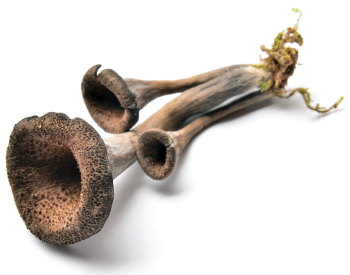
Pumpkin-colored leaves parachute down and settle softly upon the calico-colored landscape. Against a backdrop of cobalt blue, flocks of robins and redwings serenade the harvest season with migration songs. Distant hillsides are stitched together with a rag-tag patchwork of sassafras and sugar maples, oaks and evergreens. Wood smoke and fermented apples waft through the autumn air; it’s a deceptively mild breeze, and one that promises colder days ahead. T-shirts are set aside in favor of jackets that will ensure comfort in the coming chill.
Fall is a feast for the senses.
Autumn has long been synonymous with hunting. And while the pursuit of wild game like grouse and woodcock is sure to quicken any wing-shooter’s pulse, foraging for wild edibles like mushrooms and berries holds a similar allure.
Although plenty of folks devote entire weekends to hunting morels and ramps in the spring, autumn’s culinary cornucopia remains largely untapped.
Ashen-gray, funnel-shaped mushrooms called black trumpets emerge August through October. Even though they’re also known as “horns of the dead,” don’t be fooled by this fall fungi’s ominous nickname. With a distinctive, earthy taste that’s part fruity and part smoky, black trumpets boast a flavor that complements autumn’s rich, seasonal fare.
What’s more, black trumpets are excellent prospects for budding foragers because, unlike some other varieties of mushrooms, there aren’t toxic look-alikes to get confused. Check for clusters of these tasty treats along streams in lowland, hardwood forests, especially those populated by beech and oak.
For those fortunate enough to find a patch of black trumpet mushrooms, here’s a tried-and-true recipe sure to please:
Black Trumpet and Wild Rice Bisque

1/4 pound sweet butter
1 large onion, finely diced
1 to 2 cups black trumpet mushrooms (the more, the better)
2 cloves garlic, minced
1/4 cup flour
4 cups chicken stock
2 cups cooked wild rice (1/2 cup uncooked)
1 cup grated carrots
1/2 cup cherry wine
1 cup heavy cream
1 cup half-and-half
2 teaspoons dried tarragon
Salt and freshly ground pepper to taste
Melt the butter and sauté onions and garlic in a stockpot until tender. Add the carrots and mushrooms and continue to sauté until softened. Gradually mix in the flour to make a roux. Incorporate the chicken stock slowly. Add the cooked wild rice, cherry wine, heavy cream and half-and-half. Finally, add the tarragon and salt and pepper.
Like black trumpet mushrooms, autumn olive is easily identified and thrives throughout the Great Lakes region. Its ruby-hued fruit is speckled with distinctive, whitish flecks, while the two-tone, oval leaves are silverish underneath and dull green on top.
Even though the individual berries are small — about the size of a pea — it’s not uncommon to find autumn olive branches sagging to the ground under a burden of ripe fruit come October.
With a bright, lip-smacking flavor, autumn olive is especially suited for making jelly, fruit leather and pies. As an added benefit, this fall fruit is reportedly chock full of lycopene, a chemical said to have antioxidant benefits and promote prostate health. Autumn olive berries begin to ripen in September, with peak picking in October.
Unlike the lesser-known autumn olive, apples have always been a popular pick. Family-owned orchards are fail-safe autumn destinations, featuring hayrides, cider donuts, and U-pick options. But Michigan’s signature fall fruit can be harvested elsewhere, too — for free.
Wizened, largely forgotten apple trees are scattered throughout Michigan’s public lands. Though wild varieties are sure to be smaller and less manicured than their commercial cousins, they’re also likely to be free of pesticides and herbicides. Besides, it’s hard to argue with the enticing aroma of freshly picked, wild apples sautéed in butter, with a touch of brown sugar and cinnamon.
Come autumn, the landscape is a kaleidoscope of dazzling colors. There’s an invigorating snap in the air that gets the blood flowing and begs a second cup of coffee. Harvest time is here and a bounty of goodies is prime for the picking.
Now is the time to indulge.
To the woods!

Fall foraging doesn’t require much equipment, but here are a few items that can make the journey even more enjoyable:
Compass or GPS – While some folks favor GPS units to stay oriented, a simple compass works without batteries or satellite reception.
Walking stick – Save those backs and knees! Probe the mysteries of the forest floor without stooping over!
Insect repellent – Though rarely needed in fall, repellent keeps biting bugs like ticks and mosquitoes at bay.
Proper attire – Dress in wicking layers and don’t forget the Gore-Tex when rain is in the forecast. Quality boots are essential, too, as foraging often involves lots of hiking.
Bag or backpack – While some opt for a canvas shoulder bag and zip lock bags, others favor a light backpack to carry necessities and wild edibles.
Camera – Foraging offers rare glimpses at the natural world. Don’t forget a sturdy camera to capture encounters with elusive wildlife and stunning autumn scenery.
Field guide – The Audubon Field Guide series ensures positive identification of wild edibles.
Author and freelance writer Jon Osborn resides in Holland.







Facebook Comments